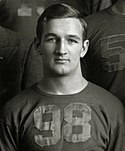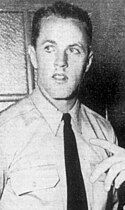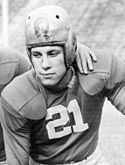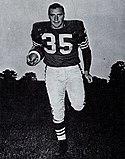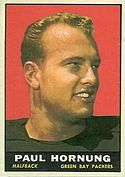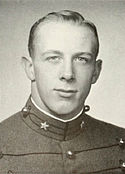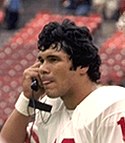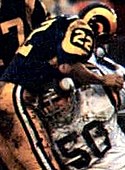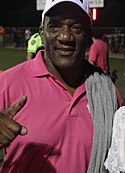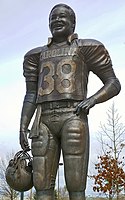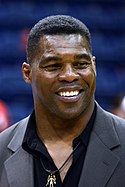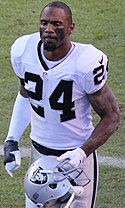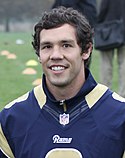List of Heisman Trophy winners
 From Wikipedia - Reading time: 14 min
From Wikipedia - Reading time: 14 min
 | |
| Awarded for | The outstanding college football player whose performance best exhibits the pursuit of excellence with integrity. Winners epitomize great ability combined with diligence, perseverance, and hard work. |
|---|---|
| Presented by |
|
| History | |
| First award | HB Jay Berwanger (1935) |
| Most recent | QB Jayden Daniels (2023) |
| Website | http://www.heisman.com/ |
The Heisman Trophy, one of the highest individual awards in American college football, has been awarded annually since its creation in 1935. The trophy is given to the most outstanding college football player in the National Collegiate Athletic Association (NCAA) Division I Football Bowl Subdivision (FBS), and is awarded by the Heisman Trust, successors of the awards from the Downtown Athletic Club at an annual ceremony.
History
[edit]In 1935, the DAC Trophy was created by New York City's Downtown Athletic Club to recognize the best college football player "east of the Mississippi River".[1] In that inaugural year, the award went to Jay Berwanger from the University of Chicago. Berwanger was later drafted by the Philadelphia Eagles of the National Football League but declined to sign with them. He never played professional football for any team, instead choosing to pursue a career in business.[2] In 1936, the club's athletic director, football pioneer John Heisman, died and the trophy was renamed in his honor. Larry Kelley, the second winner of the award, was the first to win it as the "Heisman Trophy".[3] In addition to the name change, the award also became a nationwide achievement. With the new name, players west of the Mississippi became eligible; the first player from the western United States was selected in 1938, TCU quarterback Davey O'Brien.[1]
On June 10, 2010, following several years of investigation, the NCAA announced that USC running back Reggie Bush, the 2005 Heisman trophy winner, received gifts from agents while still in college. The university received major sanctions,[4][5] and there were reports that the Heisman Trophy Trust would strip his award.[6] In September of that year, Bush voluntarily forfeited his title as the 2005 winner. The Heisman Trust decided to leave the award vacated with no new winner to be announced for the season.[7] Eventually, on April 24, 2024, the Heisman Trust announced the reinstatement of Bush's trophy due to 2021 rule changes regarding player compensation.[8]
A school has had a Heisman winner in back-to-back years six times (Yale 1936–37, Army 1945–46, Ohio State 1974–75, USC 2004–05, Oklahoma 2017–18 and Alabama 2020–21). Only one player, Ohio State's Archie Griffin, has won the award twice.[9] Oklahoma is the only school to have two players win the award in back-to-back years playing the same position (quarterbacks Baker Mayfield followed by Kyler Murray).
Between 1936 and 2001, the award was given at an annual gala ceremony at the Downtown Athletic Club in New York City. The Downtown Athletic Club's facilities were damaged during the September 11, 2001 attacks. Due to financial difficulties stemming from the damage, the DAC declared bankruptcy in 2002, turning over its building to creditors. Following the club's bankruptcy and the loss of the original Downtown Athletic Club building,[10] the Yale Club of New York City assumed presenting honors in 2002 and 2003.[11][12] The ceremony was moved to the New York Marriott Marquis in Times Square for the 2002, 2003, and 2004 presentations. Between 2005 and 2019, the event was held at PlayStation Theater in Times Square.[13] The move to the PlayStation Theater allowed the Downtown Athletic Club (and ultimately, the award's successor, The Heisman Trust) to resume full control of the event (the most prominent example of which was the return of the official portraits of past winners), despite the loss of the original presentation hall.[14] Shortly after the 2019 ceremony was held, the PlayStation Theater was permanently closed; as a result, the Heisman Trust began searching for a new location to conduct the trophy presentation. The 2020 ceremony would ultimately be held at the studios of ESPN in Bristol, Connecticut due to the COVID-19 pandemic, with the ceremony being held on January 5, 2021.[15]
In terms of balloting, the fifty states of the U.S. are split into six regions (Far West, Mid Atlantic, Mid West, North East, South, South West), and six regional representatives are selected to appoint voters in their states.[16] Each region has 145 media votes, for a total of 870 votes. In addition, all previous Heisman winners may vote, and one final vote is counted through public balloting. The Heisman ballots contain a 3–2–1 point system, in which each ballot ranks the voter's top three players and awards them three points for a first-place vote, two points for a second-place vote, and one point for a third-place vote. The points are tabulated, and the player with the highest total of points across all ballots wins the Heisman Trophy.[17]
List of Heisman Trophy winners
[edit]| * | First overall draft pick in the NFL draft | ||||
| † | Inducted into the Pro Football Hall of Fame | ||||
| ‡ | First overall pick and Pro Football Hall of Fame member | ||||
- ^ Unless otherwise noted, these positions are for the NFL draft following their Heisman victory.
- ^ Dawkins instead opted for a military career.
- ^ Ward instead opted for a basketball career, and was drafted 26th in the 1994 NBA draft.
Trophies won by school
[edit]This is a list of the colleges and universities who have had a player win a Heisman trophy. USC has the most trophies with eight. Ohio State has the distinction of the only two-time winner, Archie Griffin. In total, players from 40 schools have won a Heisman Trophy, while 19 schools have more than one trophy.
Trophies won by position
[edit]This is a list of the positions of players who have won a Heisman Trophy.
| Position | Trophies |
|---|---|
| CB | 1 |
| End | 2 |
| FB | 2 |
| HB | 17 |
| HB/LP/FB | 1 |
| HB/P | 1 |
| HB/QB | 2 |
| LB | 1 |
| QB | 36 |
| QB/WR | 1 |
| RB | 21 |
| WR | 2 |
| WR/P | 1 |
| WR/PR | 1 |
Retroactive selections
[edit]In 2009, the National Football Foundation (NFF) retroactively selected Heisman Trophy winners for the years between 1889 and 1934. The selections were made by sportswriter and NFF historian Dan Jenkins and published by the NFF.[20]
References
[edit]- ^ a b Lighten up. (Heisman Trophy) Mark Purdy, The Sporting News, encyclopedia.com. December 5, 1994. Accessed March 8, 2008. (Site defunct prior to 9/10) Archived February 5, 2008, at the Wayback Machine
- ^ Jay Berwanger, first winner of the Heisman Trophy, 1914–2002 Archived May 11, 2008, at the Wayback Machine Julia Morse, University of Chicago News Office. Chicago, Illinois. June 27, 2002. Accessed March 7, 2008.
- ^ "The Heisman Trophy". heisman.com. Archived from the original on January 3, 2012. Retrieved January 2, 2012.
- ^ USC punished with two-year football postseason ban . ESPN, June 11, 2010.
- ^ "NCAA infraction report" (PDF). Archived from the original (PDF) on December 5, 2010. Retrieved September 20, 2010.
- ^ "news: Heisman Trust leader denies decision to revoke Bush's trophy". NFL. September 7, 2010. Archived from the original on August 9, 2020. Retrieved September 20, 2010.
- ^ "Reggie Bush's Heisman to stay vacated". ESPN. September 16, 2010. Archived from the original on January 10, 2016.
- ^ "Reggie Bush to have Heisman Trophy returned". ESPN. April 24, 2024. Archived from the original on April 24, 2024. Retrieved April 24, 2024.
- ^ Archie Griffin Archived January 4, 2012, at the Wayback Machine Heisman.com. Accessed December 23, 2012.
- ^ New York landmark's closing leaves Heisman homeless Wayne Drehs, ESPN.com. July 22, 2004. Accessed March 8, 2008.
- ^ 9-11 Forces Heisman to Move to Yale Club Archived June 27, 2023, at the Wayback Machine Christopher Hunt, New York Daily News. June 26, 2002. Accessed December 14, 2018.
- ^ Heisman Trophy Dinner Becomes Feast for the Public Archived December 15, 2018, at the Wayback Machine The Washington Post. November 7, 2003. Accessed December 14, 2018.
- ^ "Downtown Athletic Club". nyc-architecture.com. Archived from the original on February 19, 2008. Retrieved March 7, 2008.
- ^ Bush runs away with Heisman Trophy Ivan Maisel, ESPN.com. December 10, 2005. Accessed March 8, 2008.
- ^ "Heisman Trophy to be awarded virtually Jan. 5". ESPN.com. November 14, 2020. Archived from the original on November 15, 2020. Retrieved November 16, 2020.
- ^ Expanded Heisman Trophy Voting Results Archived February 18, 2008, at the Wayback Machine MSNBC.com. Accessed March 8, 2008.
- ^ "Heisman Trophy Balloting". heisman.com. Archived from the original on July 23, 2012. Retrieved January 2, 2012.
- ^ Chisholm, Kari. "A plea to sportswriters for statistical accuracy". Stiff Arm Trophy. Archived from the original on January 7, 2012. Retrieved December 19, 2011.
- ^ Huston, Chris (May 22, 2019). "Heisman winners in the NFL draft (Updated)". Heisman. Archived from the original on December 12, 2021. Retrieved May 1, 2021.
- ^ Dan Jenkins (2009). "The Definitive Retroactive Heisman Memorial Trophy" (PDF). National Football Foundation's Footballeter. Archived from the original (PDF) on January 26, 2013. Retrieved September 11, 2016.
External links
[edit]
 KSF
KSF


